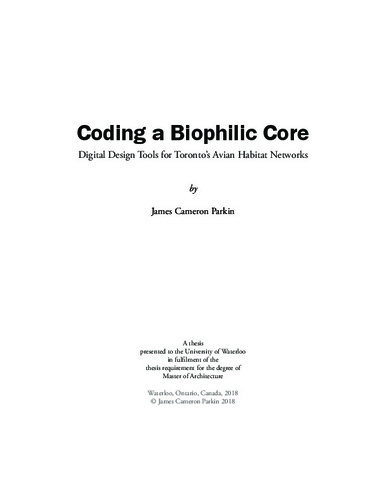| dc.description.abstract | This research develops a methodology for computationally sensing, illustrating, and utilizing avian-focused patch networks to locate and inform ecological interventions in dense urban settings. These interventions are designed to extend the range of regional avian ecosystems, promoting beneficial urbanite-fauna interaction, often referred to as biophilia. This research is in response to Toronto’s rapid densification, where in recent years, there has been a major increase of residential and mixed-use development in the downtown and central waterfront areas. Literature shows that as populations move to urban centers, there is a need for people to have access to thriving, biodiverse green space to foster mental health and environmental responsibility. At the same time, experts in landscape architecture and urbanism critique existing approaches to providing green space in cities, which often lead to sterile, ornamental lawns that limit urban biodiversity. To move beyond this approach, experts call for more dynamic and complex strategies in urban ecology.
As a response, this work explores computational methods of modeling networks and habitats that are borrowed from landscape ecology, graph theory, and parametric architecture, in the pursuit of a design methodology that thrives amidst the complexity and dynamic nature of urban and ecological systems. The resulting body of work involves simulating two dimensional and three-dimensional agent movement within patch networks, populating these networks with bird sighting data, and using this information to locate and inform a variety of intervention typologies. The work generated in this thesis is broken into three parts, with each part exploring a progressively smaller piece of urban fabric. The first part maps patch networks and suggests interventions in Toronto’s downtown and central waterfront, the second part explores how these interventions affect bird movement in the three-dimensional fabric of CityPlace and Fort York, and the final part composes an artificial habitat that attracts local bird species and acts as a biophilic amenity for urbanites in CityPlace’s Canoe Landing Park. | en |

